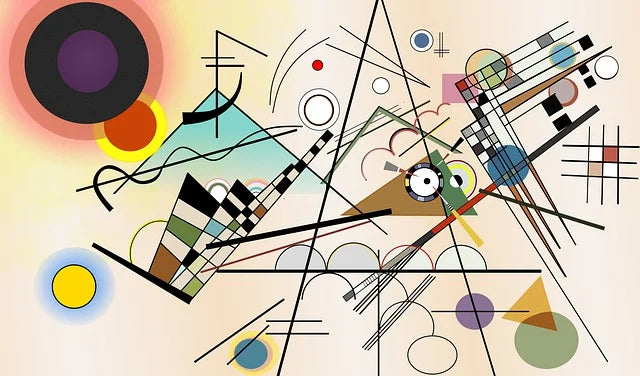
Wassily Kandinsky's Life: A Symphony of Colors
Share
In the annals of modern art, few names resonate with the revolutionary spirit quite like Wassily Kandinsky. Hailed as a pioneer of abstract art, Kandinsky's journey was as vibrant and complex as his canvases. His life, marked by geographical shifts, political upheavals, and profound intellectual explorations, forged a unique artistic vision. At Wallartjournal.com, we celebrate artists who dared to see the world differently, and Kandinsky, with his extraordinary blend of Russian heritage, German intellectualism, and French artistic sensibilities, offers a compelling narrative of art's evolution. This article delves into the turbulent life and groundbreaking influence of a true master who sought to paint the unseen.
Early Life and the Stirrings of Abstraction in Russia
Born in Moscow in 1866, Wassily Kandinsky's early life was steeped in Russian culture and intellectual pursuits. Initially pursuing law and economics, his path took a dramatic turn after experiencing an exhibition of French Impressionists in Moscow, particularly Monet's "Haystacks." This encounter, coupled with his lifelong experience of synesthesia (a condition where he "saw" colors when hearing music and "heard" sounds when seeing colors), ignited an irresistible call to art.
His formative years in Russia exposed him to vibrant folk art, icon painting, and the rich spiritual traditions of the Orthodox Church, all of which subtly influenced his later work. These early impressions laid the groundwork for his belief in the spiritual power of color and form, a cornerstone of his move towards pure abstraction. He eventually abandoned his academic career to study art in Munich in 1896, a bold move that set him on his revolutionary artistic trajectory.
Munich and the Birth of a New Language: Der Blaue Reiter
Upon arriving in Munich, then a vibrant European art center, Kandinsky immersed himself in the avant-garde scene. His early paintings were still figurative, often landscapes or fairy-tale scenes, but already hinted at a burgeoning fascination with color's expressive potential. It was during this period that he began to articulate his theories on the spiritual in art, culminating in his seminal book, Concerning the Spiritual in Art (1911).
A pivotal moment arrived in 1910, when Kandinsky painted what is widely considered the first abstract watercolor, a work that liberated form and color from representational duties. This marked his definitive break from traditional art. In 1911, alongside Franz Marc, he co-founded Der Blaue Reiter (The Blue Rider), an influential Expressionist movementthat sought to explore the spiritual dimensions of art and express inner realities rather than external appearances. The group's almanacs and exhibitions were crucial in disseminating the ideas of abstract art theory across Europe.
Wartime Disruption and Return to Revolutionary Russia
The outbreak of World War I in 1914 shattered the vibrant European art scene and forced Kandinsky, an enemy alien in Germany, to return to Moscow. This period was marked by personal and artistic challenges. While he initially embraced the revolutionary fervor, becoming involved in the reorganization of art education and museums, his increasingly spiritual and individualistic approach to abstraction clashed with the emerging utilitarian and constructivist ideals of the Soviet art establishment.
His work during this time saw a shift towards more geometric and structured forms, influenced by the prevailing avant-garde movements in Russia. Despite his significant contributions, the growing ideological constraints led to his disillusionment, and by 1921, he sought opportunities to continue his artistic and theoretical explorations elsewhere.
The Bauhaus Years: Geometry, Theory, and Teaching
In 1922, Kandinsky accepted an invitation to teach at the renowned Bauhaus art school in Weimar, Germany. This period was incredibly productive for him, both as an artist and a theorist. At the Bauhaus, he further developed his theories on the psychological effects of color and form, exploring the relationship between points, lines, and planes. His teaching profoundly influenced a new generation of artists, and his second major theoretical work, Point and Line to Plane (1926), became a foundational text for geometric abstraction.
His paintings from the Bauhaus era are characterized by precise geometric shapes, vibrant colors, and a meticulous exploration of composition. He was deeply engaged in the rational and systematic approach to art that the Bauhaus advocated, yet always maintained his belief in the spiritual essence of artistic creation. The rise of Nazism, however, cast a dark shadow. The Bauhaus was eventually forced to close in 1933, deemed "degenerate art" by the regime, leading to another forced migration for Kandinsky.
Parisian Light and Final Evolutions in France
Fleeing Nazi persecution, Kandinsky moved to Paris in 1933, where he would spend the last decade of his life. Despite initial struggles for recognition in a Parisian art scene dominated by Surrealism and Cubism, he continued to evolve his unique style. His work from this period often incorporated biomorphic, amoeba-like forms, inspired by scientific illustrations and microscopic organisms. These organic shapes, combined with his characteristic vibrant colors, created a new language of abstract expressionism that was both playful and profound.
The looming threat of World War II and the occupation of France undoubtedly impacted his later years, but his commitment to art remained unwavering. He continued to paint until his death in 1944, leaving behind a vast and influential body of work.
A Lasting Legacy: The Father of Abstraction
Wassily Kandinsky's Kandinsky legacy is immense. He not only pioneered abstract painting but also provided a theoretical framework for it, articulating the spiritual and emotional power of non-representational art. His journey, marked by multiple exiles and constant artistic evolution, reflects a relentless pursuit of a universal artistic language. From the vibrant folk art of Russia to the intellectual rigor of the Bauhaus and the artistic freedom of Paris, Kandinsky absorbed and transformed influences, ultimately creating a truly unique and enduring contribution to modern art history. His work continues to inspire artists and art lovers worldwide, inviting us to see beyond the visible and connect with the profound symphony of colors and co
